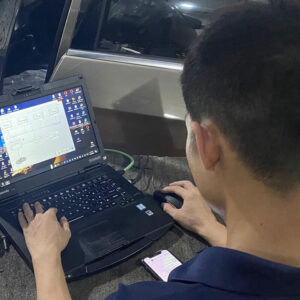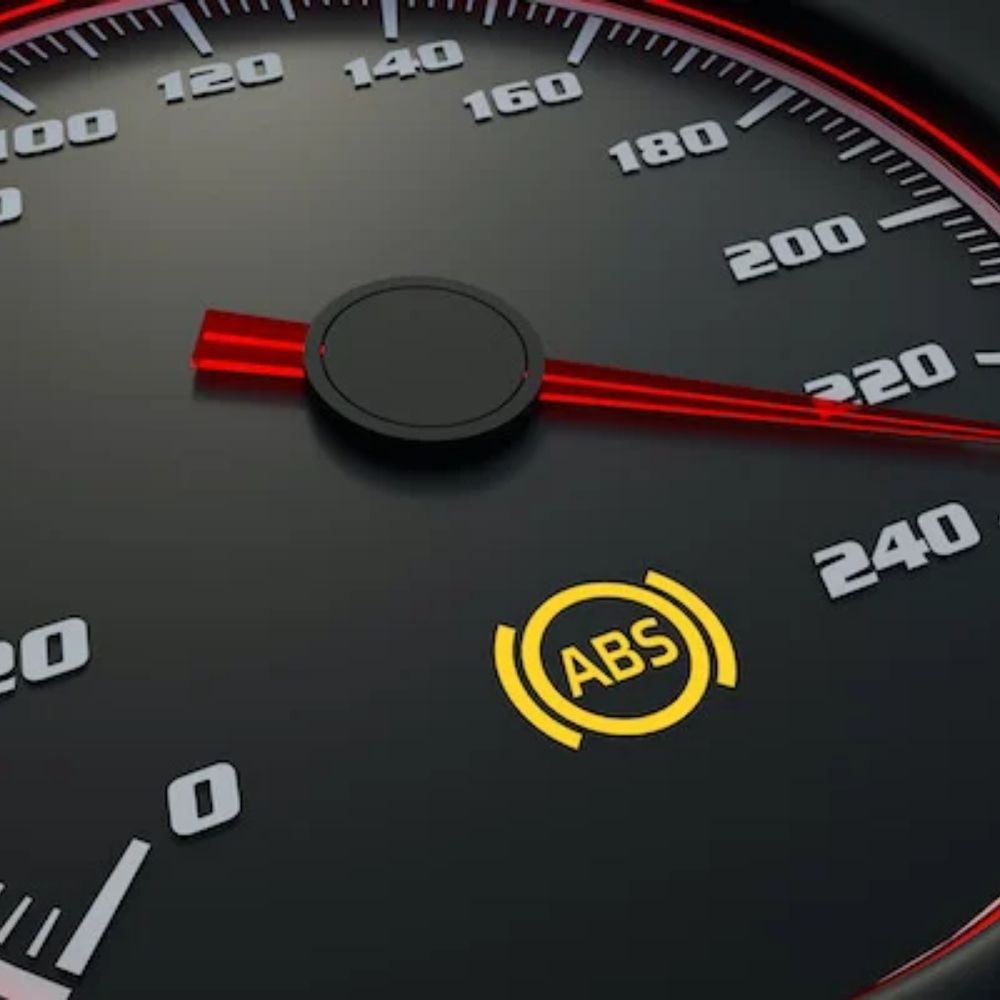
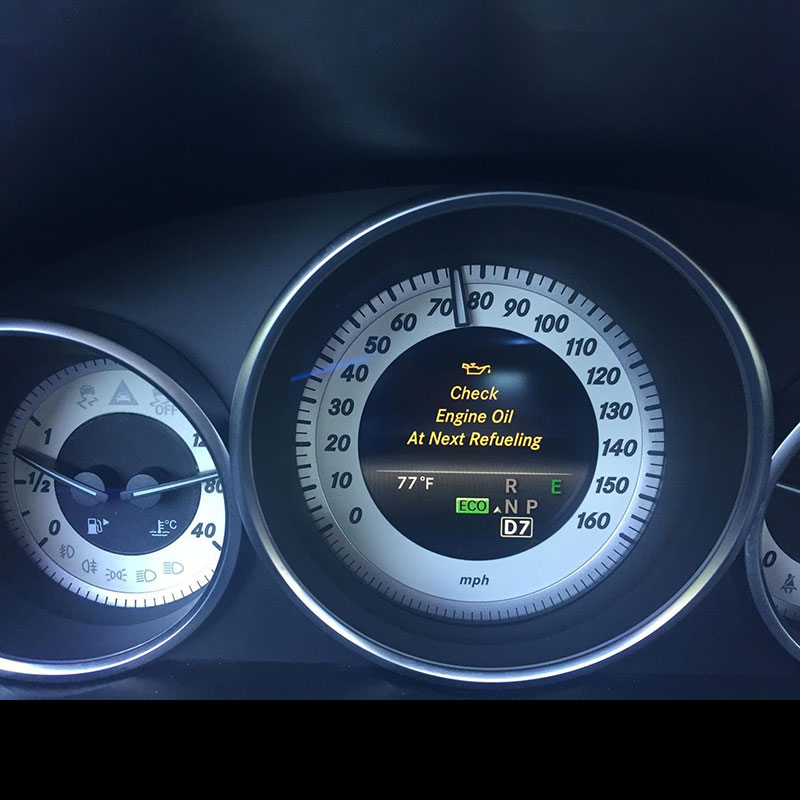
Mercedes Benz Code P052E: Causes, Diagnosis, and Solutions
Contents
- 1. Understanding Mercedes Benz Code P052E
- 1.1. What Does Mercedes Benz Code P052E Mean?
- 1.2. Common Symptoms of Code P052E Mercedes
- 1.3. Potential Impact on Your Mercedes Benz
- 1.4 Affected Mercedes-Benz Models and Years
- 2. Common Causes of Mercedes Benz Code P052E
- 2.1. Faulty PCV Valve
- 2.2. Vacuum Leaks
- 2.3. Electrical Issues
- 2.4. Sensor Problems
- 3. Recommended Tools to Diagnosis & Fix Mercedes Code P052E
- 4. Diagnosing Mercedes Benz Code P052E: A Step-by-Step Guide
- 4.1. Preliminary Inspection
- 4.2. Retrieving and Clearing the Code
- 4.3. Testing the PCV Valve
- 4.4. Checking for Vacuum Leaks
- 4.5. Testing Electrical Components
- 4.6. Inspecting Sensors
- 4.7. Checking Fuel Trims
- 5. Repairing Mercedes Benz Code P052E: Solutions and Procedures
- 5.1. Replacing the PCV Valve
- 5.2. Repairing Vacuum Leaks
- 5.3. Repairing Electrical Issues
- 5.4. Cleaning or Replacing Sensors
- 6. Preventing Future Issues with Your Mercedes Benz PCV System
- 6.1. Regular PCV Valve Inspection and Maintenance
- 6.2. Maintaining Clean Engine Oil
- 6.3. Checking and Replacing Hoses
- 6.4. Monitoring Engine Performance
- 7. Real-World Examples of Resolving Mercedes Benz Code P052E
- 7.1. Case Study 1: Faulty PCV Valve
- 7.2. Case Study 2: Vacuum Leak in PCV System
- 7.3. Case Study 3: Electrical Issue with PCV Valve
- 🚗 Need Help with Mercedes-Benz Code P052E? Let AutoExplain Handle It!
- Frequently Asked Questions (FAQs) About Mercedes Benz Code P052E
- 1. What Does Code P052E Specifically Indicate in a Mercedes Benz?
- 2. Can I Drive My Mercedes Benz with Code P052E?
- 3. How Often Should I Replace the PCV Valve in My Mercedes Benz?
- 4. What Are the Symptoms of a Bad PCV Valve in a Mercedes Benz?
- 5. Can a Vacuum Leak Cause Code P052E?
- 6. How Can I Check for Vacuum Leaks in My Mercedes Benz?
- 7. Is It Possible to Clean a PCV Valve Instead of Replacing It?
- 8. What Tools Are Needed to Diagnose Code P052E?
- 9. How Can AutoExplain.com Help Me Resolve Code P052E?
- 10. What Are the Long-Term Consequences of Ignoring Code P052E?
Mercedes Benz Code P052e indicates a fault in the positive crankcase ventilation (PCV) system. AutoExplain.com offers expert insights and remote support to diagnose and resolve this issue efficiently. Understanding the nuances of this code and the intricacies of the PCV system can save you time and money, especially with the advanced diagnostic tools and assistance available through our platform, which delivers optimal vehicle performance and addresses emission control issues.
1. Understanding Mercedes Benz Code P052E
Mercedes Benz code P052E indicates a malfunction within the Positive Crankcase Ventilation (PCV) system, specifically related to the PCV regulator valve performance. This section dives deep into the definition, symptoms, and potential impacts of this code on your Mercedes Benz.
1.1. What Does Mercedes Benz Code P052E Mean?
The OBD-II diagnostic trouble code P052E is defined as “Positive Crankcase Ventilation Regulator Valve Performance.” The PCV system is essential for managing crankcase gases, preventing pressure buildup, and reducing harmful emissions. When the engine runs, combustion gases can leak past the piston rings into the crankcase; this is known as “blow-by.” These gases contain hydrocarbons and other pollutants that, if not properly managed, can cause environmental damage and engine performance issues.
The PCV system’s primary function is to vent these gases back into the intake manifold to be re-burned during the combustion process. The PCV valve regulates the flow of these gases, ensuring optimal pressure levels within the crankcase. Code P052E is triggered when the engine control unit (ECU) detects that the PCV regulator valve is not performing as expected. This could be due to a variety of issues, such as a malfunctioning valve, electrical problems in the control circuit, or vacuum leaks.
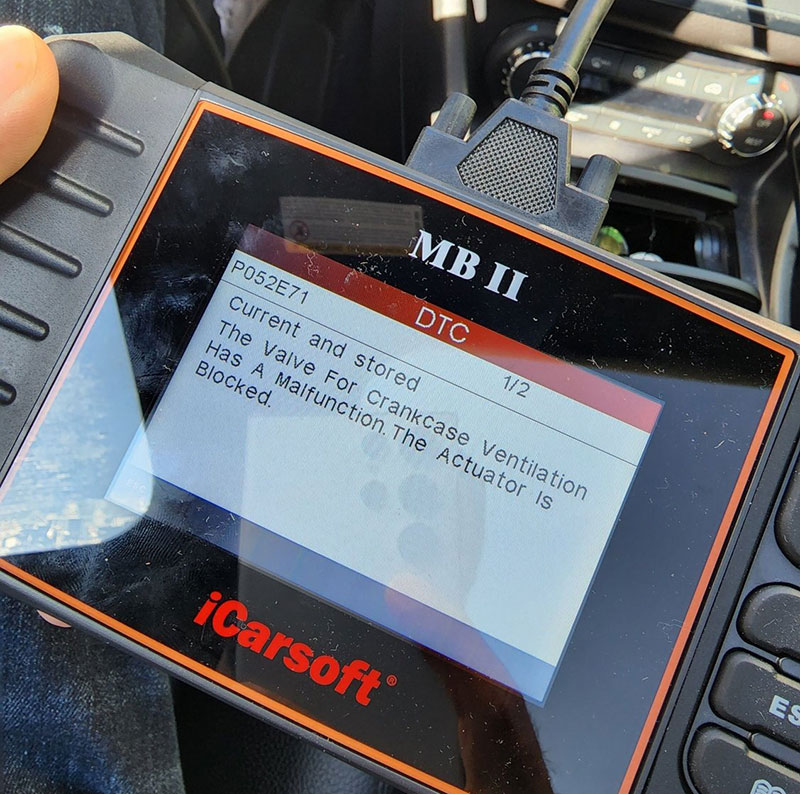
1.2. Common Symptoms of Code P052E Mercedes
When code P052E is triggered, several symptoms may manifest, affecting the performance and efficiency of your Mercedes Benz:
- Check Engine Light: The most obvious symptom is the illumination of the check engine light on the dashboard. This light indicates that the ECU has detected a problem within one of the vehicle’s systems, in this case, the PCV system.
-
Diagnostic Double Code: Stored fault code P052E or P052E71 in the engine control module
- Rough Idle: A faulty PCV valve can cause the engine to idle roughly. The uncontrolled flow of crankcase gases into the intake manifold disrupts the air-fuel mixture, leading to an unstable idle.
- Poor Fuel Economy: The improper regulation of crankcase gases can affect the engine’s combustion process, resulting in decreased fuel efficiency. You might notice that you need to fill up your gas tank more frequently.
- Engine Misfires: In severe cases, an issue with the PCV system can lead to engine misfires. Misfires occur when one or more cylinders do not fire correctly, leading to a loss of power and potential engine damage.
- Oil Leaks: A malfunctioning PCV system can cause pressure to build up in the crankcase, which can then force oil past seals and gaskets, leading to oil leaks. These leaks can be found around the valve cover, crankshaft, or other engine components.
- Whistling Noise: A vacuum leak in the PCV system can sometimes produce a whistling noise, especially noticeable at idle. This noise is caused by air being sucked into the engine through the leak.
- Increased Oil Consumption: A faulty PCV valve can lead to increased oil consumption as oil vapors are drawn into the intake manifold and burned along with the air-fuel mixture.
1.3. Potential Impact on Your Mercedes Benz
Ignoring code P052E can lead to several long-term issues affecting your Mercedes Benz:
- Catalytic Converter Damage: The improper burning of crankcase gases can lead to increased emissions, which can overwhelm and damage the catalytic converter over time. Replacing a catalytic converter can be an expensive repair.
- Engine Damage: Continuous pressure buildup in the crankcase can cause significant engine damage, including blown seals and gaskets. Severe cases may even lead to engine failure.
- Failed Emissions Test: If your vehicle is subject to emissions testing, a malfunctioning PCV system will likely cause it to fail. This can prevent you from legally operating your vehicle.
- Reduced Engine Performance: The cumulative effect of a faulty PCV system can significantly reduce engine performance, leading to a less responsive and less efficient vehicle.
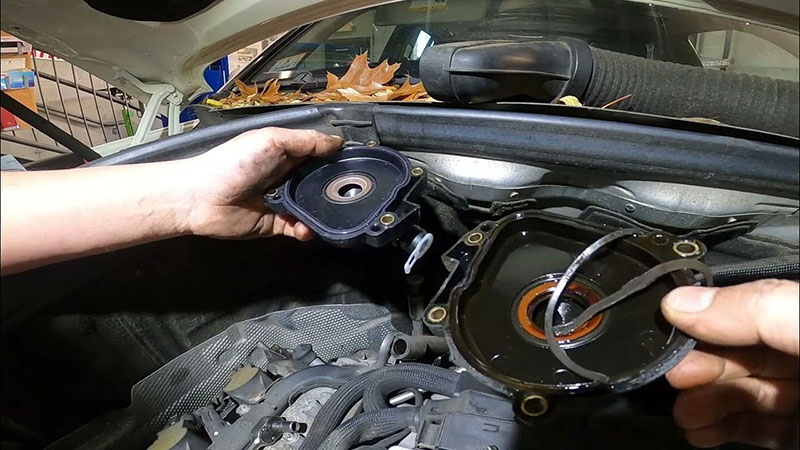
1.4 Affected Mercedes-Benz Models and Years
The P052E fault code is prevalent in Mercedes-Benz vehicles equipped with the M274 four-cylinder turbocharged engine, particularly models manufactured between 2015 and 2019. Here’s a list of commonly affected models:
-
C300 (W205 chassis)
-
E300
-
GLC300 (X253 chassis)
-
CLA-Class
-
GLA-Class
Knowing if your vehicle is prone to this issue is the first step in proactively managing its maintenance. Understanding the nuances of Troubleshooting Mercedes P052E and Mercedes PCV System Malfunction P052E will also be beneficial.
2. Common Causes of Mercedes Benz Code P052E
Understanding the potential causes of Mercedes Benz code P052E is crucial for accurate diagnosis and effective repair. This section outlines the most common reasons why this code may be triggered in your vehicle.
2.1. Faulty PCV Valve
The most common cause of code P052E is a malfunctioning PCV valve. The PCV valve regulates the flow of crankcase gases into the intake manifold. Over time, this valve can become clogged with oil deposits, carbon buildup, or other contaminants, which can impede its ability to function correctly.
- Clogging: Deposits can restrict the valve’s movement, causing it to stick in either the open or closed position. A valve stuck open can allow too much crankcase gas to enter the intake, leading to a rich air-fuel mixture and rough idle. Conversely, a valve stuck closed can cause pressure to build up in the crankcase.
- Diaphragm Damage: Many PCV valves contain a diaphragm that regulates the flow of gases. This diaphragm can become cracked, torn, or otherwise damaged, leading to improper valve operation.
- Electrical Malfunction: Some modern PCV valves are electronically controlled. A failure in the valve’s electrical components can prevent it from operating as intended.
2.2. Vacuum Leaks
Vacuum leaks in the PCV system can also trigger code P052E. Vacuum leaks allow unmetered air to enter the engine, disrupting the air-fuel mixture and affecting the PCV system’s performance.
- Hose Damage: The hoses connecting the PCV valve to the intake manifold and other engine components can become cracked, brittle, or disconnected over time. These damaged hoses can create vacuum leaks.
- Loose Connections: Loose or improperly installed connections in the PCV system can also cause vacuum leaks. Ensure that all connections are secure and properly sealed.
- Intake Manifold Gasket: A leaking intake manifold gasket can create a vacuum leak that affects the PCV system. This gasket seals the intake manifold to the cylinder head, and if it fails, it can allow air to enter the engine.
2.3. Electrical Issues
Electrical problems in the PCV system’s control circuit can also lead to code P052E. These issues can prevent the PCV valve from functioning correctly.
- Wiring Damage: Damaged, corroded, or shorted wiring in the PCV valve’s control circuit can disrupt the signal between the ECU and the valve.
- Connector Problems: Loose, corroded, or damaged connectors can also interrupt the electrical signal. Check the connectors at the PCV valve and the ECU for any signs of damage or corrosion.
- ECU Malfunction: In rare cases, a malfunction in the ECU can cause code P052E. The ECU controls the PCV valve, and if it fails to send the correct signals, the valve will not operate as intended.
2.4. Sensor Problems
Issues with sensors related to the PCV system can also trigger code P052E. These sensors provide feedback to the ECU about the system’s performance.
- MAF Sensor: The Mass Air Flow (MAF) sensor measures the amount of air entering the engine. If the MAF sensor is dirty or malfunctioning, it can provide inaccurate readings, affecting the PCV system’s operation.
- Oxygen Sensors: Oxygen sensors monitor the oxygen content in the exhaust gases. Problems with these sensors can also affect the air-fuel mixture and trigger code P052E.
3. Recommended Tools to Diagnosis & Fix Mercedes Code P052E
- OBD-II Scanner (Diagnostic Tool)
- Mercedes SD Connect DoIP C4 / C5 / C6 Device
- Xentry Diagnosis Software (Openshell or Passthru)
- Multimeter
- Smoke Machine (for Vacuum Leaks)
- Vacuum Pump (for Testing the PCV Valve)
- Oscilloscope (Optional for ECU Signal Testing)
- MAF Sensor Cleaner and Electrical Contact Cleaner
- Basic Hand Tools (Sockets, Wrenches, Screwdrivers, Pliers)
4. Diagnosing Mercedes Benz Code P052E: A Step-by-Step Guide
Diagnosing Mercedes Benz code P052E requires a systematic approach to identify the root cause of the problem. This section provides a detailed, step-by-step guide to help you accurately diagnose this code.
4.1. Preliminary Inspection
Before diving into more complex diagnostic procedures, start with a thorough visual inspection of the PCV system.
- Check the PCV Valve: Locate the PCV valve and inspect it for any signs of damage, such as cracks, leaks, or excessive buildup of oil and carbon deposits.
- Inspect Hoses and Connections: Examine all hoses and connections in the PCV system for cracks, disconnections, or other damage. Ensure that all connections are secure.
- Check Wiring and Connectors: Inspect the wiring and connectors associated with the PCV valve for any signs of damage, corrosion, or loose connections.
- Look for Oil Leaks: Check the engine for any signs of oil leaks, particularly around the valve cover, crankshaft, and other engine components. Oil leaks can indicate a pressure buildup in the crankcase due to a malfunctioning PCV system.
4.2. Retrieving and Clearing the Code
Use an OBD-II scanner to retrieve the stored diagnostic trouble codes from the vehicle’s ECU.
- Connect the Scanner: Plug the OBD-II scanner into the diagnostic port, typically located under the dashboard on the driver’s side.
- Retrieve Codes: Turn on the ignition and follow the scanner’s instructions to retrieve the stored codes. Record all codes present, as there may be other related codes that can provide additional information.
- Clear the Code: After recording the codes, clear code P052E and any other related codes. This will allow you to see if the code returns after performing diagnostic tests.
4.3. Testing the PCV Valve
The PCV valve is a critical component of the system, so it’s essential to test its functionality.
- Visual Inspection: Remove the PCV valve and inspect it closely. Look for any signs of damage, such as cracks, excessive buildup, or a stuck valve.
- Shake Test: Shake the PCV valve to see if the internal components move freely. If the valve is stuck or doesn’t rattle, it may be clogged or damaged.
- Vacuum Test: With the engine running, disconnect the PCV valve from its hose and place your finger over the valve opening. You should feel a strong vacuum. If there is little or no vacuum, there may be a problem with the valve or the vacuum source.
- Voltage Test (if applicable): If the PCV valve is electronically controlled, use a multimeter to check the voltage at the valve connector. Ensure that the valve is receiving the correct voltage from the ECU. Refer to the vehicle’s service manual for the specified voltage range.
4.4. Checking for Vacuum Leaks
Vacuum leaks can significantly affect the PCV system’s performance. Use a smoke machine or other diagnostic tools to check for vacuum leaks.
- Smoke Test: Connect a smoke machine to the PCV system and introduce smoke into the system. Observe the hoses, connections, and intake manifold for any signs of smoke escaping, which indicates a vacuum leak.
- Spray Test: With the engine running, spray carburetor cleaner or starting fluid around the hoses, connections, and intake manifold. Listen for any changes in the engine’s idle speed. If the idle speed increases, it indicates that the cleaner is being sucked into the engine through a vacuum leak.
- Pressurize the System: Connect the smoke machine to the PCV system and introduce smoke under low pressure.
- Inspect Closely: Use a flashlight to carefully inspect all hoses, connections, and components for any signs of escaping smoke. Pay close attention to areas that are difficult to reach or see.
- Check the Intake Manifold: Smoke can be introduced into the intake manifold to check for leaks around the gasket and other seals.
- Evaluate Results: Any escaping smoke indicates a leak that needs to be addressed. Repair or replace the leaking component as necessary.
4.5. Testing Electrical Components
If the PCV valve is electronically controlled, perform electrical tests to ensure that the control circuit is functioning correctly.
- Continuity Test: Use a multimeter to check the continuity of the wiring between the PCV valve connector and the ECU. Ensure that there are no breaks or shorts in the wiring.
- Resistance Test: Check the resistance of the PCV valve’s solenoid. Compare the measured resistance to the manufacturer’s specifications. A significant deviation from the specified range indicates a faulty valve.
- Signal Test: Use an oscilloscope or multimeter to check the signal from the ECU to the PCV valve. Ensure that the ECU is sending the correct signals to control the valve.
4.6. Inspecting Sensors
Problems with the MAF sensor or oxygen sensors can affect the PCV system.
- MAF Sensor Test: Use a scan tool to monitor the MAF sensor readings. Compare the readings to the manufacturer’s specifications. Clean the MAF sensor with a MAF sensor cleaner if it appears dirty.
- Oxygen Sensor Test: Use a scan tool to monitor the oxygen sensor readings. Ensure that the sensors are switching correctly and providing accurate feedback to the ECU.
4.7. Checking Fuel Trims
Fuel trims can provide valuable insights into the engine’s air-fuel mixture and can help identify issues with the PCV system.
- Monitor Short-Term and Long-Term Fuel Trims: Use a scan tool to monitor the short-term fuel trim (STFT) and long-term fuel trim (LTFT) values.
- Analyze Fuel Trim Values: High positive fuel trim values indicate that the engine is running lean, which can be caused by a vacuum leak or a malfunctioning PCV valve. High negative fuel trim values indicate that the engine is running rich, which can be caused by a stuck-open PCV valve.
- Diagnose Issues: Use the fuel trim data to diagnose issues with the PCV system, MAF sensor, oxygen sensors, or fuel injectors.
5. Repairing Mercedes Benz Code P052E: Solutions and Procedures
Once you have diagnosed the cause of Mercedes Benz code P052E, the next step is to implement the appropriate repairs. This section provides detailed solutions and procedures for addressing the common causes of this code.
5.1. Replacing the PCV Valve
If the PCV valve is found to be faulty, replacing it is often the most effective solution.
- Gather Necessary Tools: You will need a new PCV valve, sockets, wrenches, screwdrivers, and gloves.
- Locate the PCV Valve: Refer to your vehicle’s service manual to locate the PCV valve. It is typically located on the valve cover or intake manifold.
- Disconnect Hoses: Carefully disconnect the hoses connected to the PCV valve. Use pliers if necessary to loosen any clamps.
- Remove the Old Valve: Remove the old PCV valve. It may be threaded or secured with a clip or fastener.
- Install the New Valve: Install the new PCV valve, ensuring that it is properly seated and secured.
- Reconnect Hoses: Reconnect the hoses to the PCV valve, ensuring that all connections are tight and secure.
- Test the System: Start the engine and check for any leaks or unusual noises. Use an OBD-II scanner to clear code P052E and monitor the system to ensure that the code does not return.
5.2. Repairing Vacuum Leaks
Addressing vacuum leaks in the PCV system is essential for restoring proper function.
- Identify the Leak: Use a smoke machine or spray test to locate the vacuum leak.
- Replace Damaged Hoses: If the leak is due to a cracked or damaged hose, replace the hose with a new one. Ensure that the new hose is the correct size and type for your vehicle.
- Secure Loose Connections: If the leak is due to a loose connection, tighten the connection or replace the clamp. Ensure that all connections are properly sealed.
- Replace Intake Manifold Gasket: If the leak is due to a faulty intake manifold gasket, replace the gasket. This is a more complex repair that may require removing the intake manifold. Follow the instructions in your vehicle’s service manual.
- Test the System: After repairing the vacuum leak, start the engine and check for any leaks or unusual noises. Use an OBD-II scanner to clear code P052E and monitor the system to ensure that the code does not return.
5.3. Repairing Electrical Issues
Addressing electrical issues in the PCV system requires careful diagnosis and repair.
- Repair Damaged Wiring: If the wiring is damaged, repair it by splicing in new wires and using heat shrink tubing to protect the connections.
- Clean or Replace Connectors: If the connectors are corroded or damaged, clean them with electrical contact cleaner or replace them with new connectors.
- Test the Circuit: Use a multimeter to test the continuity, voltage, and resistance of the circuit. Ensure that all readings are within the specified range.
- Replace the ECU (if necessary): If the ECU is found to be faulty, it may need to be replaced. This is a complex repair that should be performed by a qualified technician.
- Test the System: After repairing the electrical issues, start the engine and check for any malfunctions. Use an OBD-II scanner to clear code P052E and monitor the system to ensure that the code does not return.
5.4. Cleaning or Replacing Sensors
If the MAF sensor or oxygen sensors are found to be faulty, cleaning or replacing them may be necessary.
- Clean the MAF Sensor: Remove the MAF sensor and clean it with a MAF sensor cleaner. Follow the instructions on the cleaner to avoid damaging the sensor.
- Replace the Oxygen Sensors: If the oxygen sensors are faulty, replace them with new sensors. Ensure that you use the correct type of sensor for your vehicle.
- Test the System: After cleaning or replacing the sensors, start the engine and monitor the sensor readings with a scan tool. Ensure that the sensors are functioning correctly. Use an OBD-II scanner to clear code P052E and monitor the system to ensure that the code does not return.
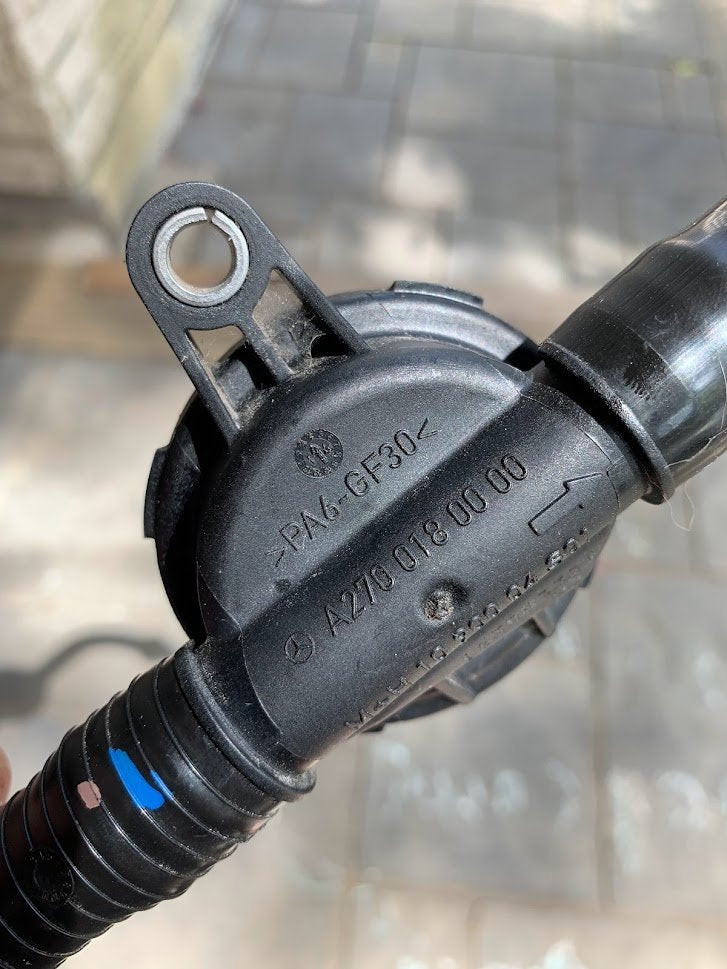 PCV
PCV
6. Preventing Future Issues with Your Mercedes Benz PCV System
Maintaining your Mercedes Benz PCV system is crucial for preventing future issues and ensuring optimal engine performance. This section provides tips and best practices for keeping your PCV system in good condition.
6.1. Regular PCV Valve Inspection and Maintenance
Regular inspection and maintenance of the PCV valve can help prevent clogging and other issues.
- Inspect Regularly: Inspect the PCV valve every 30,000 to 50,000 miles or as recommended in your vehicle’s service manual.
- Clean the Valve: If the valve appears dirty or has some buildup, clean it with carburetor cleaner. Ensure that the valve moves freely after cleaning.
- Replace as Needed: If the valve is damaged or cannot be cleaned effectively, replace it with a new valve.
6.2. Maintaining Clean Engine Oil
Using high-quality engine oil and changing it regularly can help prevent oil deposits from forming in the PCV system.
- Use High-Quality Oil: Use the type of engine oil recommended by Mercedes Benz.
- Follow Maintenance Schedule: Follow the recommended oil change intervals in your vehicle’s service manual.
- Check Oil Level Regularly: Check the engine oil level regularly and add oil as needed to maintain the correct level.
6.3. Checking and Replacing Hoses
Regularly inspect the hoses in the PCV system for cracks, leaks, or damage.
- Inspect Hoses: Inspect the hoses every 12 months or as part of your regular maintenance routine.
- Replace as Needed: Replace any hoses that are cracked, brittle, or damaged.
- Ensure Proper Fit: Ensure that the new hoses are the correct size and type for your vehicle and that they are properly installed.
6.4. Monitoring Engine Performance
Pay attention to your engine’s performance and watch for any signs of PCV system issues.
- Listen for Unusual Noises: Listen for any whistling noises or other unusual sounds coming from the engine.
- Monitor Fuel Economy: Keep track of your fuel economy and watch for any significant decreases.
- Check for Oil Leaks: Regularly check the engine for any signs of oil leaks.
- Address Issues Promptly: If you notice any signs of PCV system issues, address them promptly to prevent further damage.
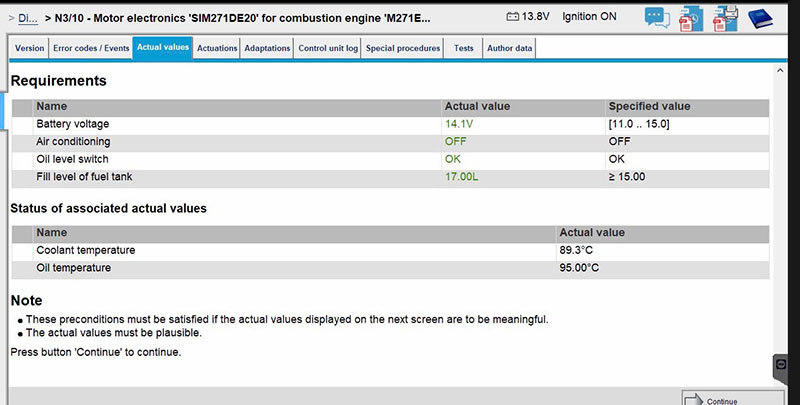
7. Real-World Examples of Resolving Mercedes Benz Code P052E
To illustrate the diagnostic and repair process for Mercedes Benz code P052E, here are a few real-world examples.
7.1. Case Study 1: Faulty PCV Valve
- Vehicle: 2016 Mercedes Benz C300
- Symptoms: Check engine light, rough idle, poor fuel economy
- Code: P052E
- Diagnosis:
- Visual inspection revealed oil buildup around the PCV valve.
- Shake test indicated that the PCV valve was not moving freely.
- Vacuum test showed weak vacuum at the PCV valve.
- Solution:
- The PCV valve was replaced with a new OEM valve.
- The code was cleared, and the engine was tested.
- Outcome:
- The check engine light turned off.
- The engine idled smoothly.
- Fuel economy returned to normal.
7.2. Case Study 2: Vacuum Leak in PCV System
- Vehicle: 2018 Mercedes Benz GLC300
- Symptoms: Check engine light, whistling noise from engine, poor performance
- Code: P052E
- Diagnosis:
- Visual inspection revealed a cracked hose in the PCV system.
- Smoke test confirmed a vacuum leak at the cracked hose.
- Solution:
- The cracked hose was replaced with a new hose.
- The code was cleared, and the engine was tested.
- Outcome:
- The check engine light turned off.
- The whistling noise disappeared.
- Engine performance returned to normal.
7.3. Case Study 3: Electrical Issue with PCV Valve
- Vehicle: 2017 Mercedes Benz E300
- Symptoms: Check engine light, intermittent rough idle
- Code: P052E
- Diagnosis:
- Visual inspection revealed no obvious damage.
- Electrical testing showed low voltage at the PCV valve connector.
- Continuity testing revealed a break in the wiring between the ECU and the PCV valve.
- Solution:
- The damaged wiring was repaired.
- The code was cleared, and the engine was tested.
- Outcome:
- The check engine light turned off.
- The engine idled smoothly.
🚗 Need Help with Mercedes-Benz Code P052E? Let AutoExplain Handle It!
Mercedes-Benz P052E code indicates a malfunction within the Positive Crankcase Ventilation (PCV) system, particularly with the PCV regulator valve. This issue can impact engine performance, fuel efficiency, and even lead to more serious engine problems if left unresolved.
At AutoExplain, we specialize in diagnosing and fixing complex automotive issues like the P052E code with ease. Our experienced technicians offer comprehensive support, including:
✅ Accurate Diagnosis using advanced Mercedes-Benz diagnostic tools
✅ Step-by-step repair guidance to help you fix the PCV system malfunction
✅ 24/7 online support for your convenience
✅ Expert Automotive Training to help you understand and fix issues on your own
Don’t let P052E slow you down—get your Mercedes-Benz back on track with AutoExplain!
📲 Contact us now via WhatsApp: +1(936)2896695
We’re here to help you get back on the road quickly and safely.
Frequently Asked Questions (FAQs) About Mercedes Benz Code P052E
Here are some frequently asked questions about Mercedes Benz code P052E, along with detailed answers to help you better understand and address this issue.
1. What Does Code P052E Specifically Indicate in a Mercedes Benz?
Code P052E indicates that the engine control unit (ECU) has detected a performance issue with the positive crankcase ventilation (PCV) regulator valve. The PCV system is designed to vent crankcase gases back into the intake manifold, and this code suggests that the valve is not functioning as expected.
2. Can I Drive My Mercedes Benz with Code P052E?
While it is possible to drive with code P052E, it is not recommended. The underlying issue can lead to rough idle, poor fuel economy, oil leaks, and potentially more severe engine damage over time. It is best to diagnose and repair the issue as soon as possible.
3. How Often Should I Replace the PCV Valve in My Mercedes Benz?
The PCV valve should be inspected regularly and replaced every 30,000 to 50,000 miles, or as recommended in your vehicle’s service manual. Regular replacement can prevent clogging and ensure proper PCV system function.
4. What Are the Symptoms of a Bad PCV Valve in a Mercedes Benz?
Common symptoms of a bad PCV valve include:
- Check engine light
- Rough idle
- Poor fuel economy
- Engine misfires
- Oil leaks
- Whistling noise from the engine
5. Can a Vacuum Leak Cause Code P052E?
Yes, a vacuum leak in the PCV system or intake manifold can cause code P052E. Vacuum leaks allow unmetered air to enter the engine, disrupting the air-fuel mixture and affecting the PCV system’s performance.
6. How Can I Check for Vacuum Leaks in My Mercedes Benz?
You can check for vacuum leaks using a smoke machine, spraying carburetor cleaner around hoses and connections, or visually inspecting hoses for cracks and damage.
7. Is It Possible to Clean a PCV Valve Instead of Replacing It?
Yes, it is possible to clean a PCV valve if it is not severely damaged. You can use carburetor cleaner to remove oil deposits and buildup. However, if the valve is cracked or cannot be cleaned effectively, it should be replaced.
8. What Tools Are Needed to Diagnose Code P052E?
Tools needed to diagnose code P052E include:
- OBD-II scanner
- Multimeter
- Smoke machine
- Vacuum gauge
- Sockets and wrenches
9. How Can AutoExplain.com Help Me Resolve Code P052E?
AutoExplain.com offers remote diagnostic assistance, access to experienced technicians, and cost-effective solutions to help you resolve code P052E. Our technicians can guide you through the diagnostic process, provide expert advice, and assist with ECU programming, navigation updates, and key programming.
10. What Are the Long-Term Consequences of Ignoring Code P052E?
Ignoring code P052E can lead to:
- Catalytic converter damage
- Engine damage
- Failed emissions test
- Reduced engine performance
- Increased oil consumption
Addressing the issue promptly can prevent these long-term consequences and ensure the continued performance and reliability of your Mercedes Benz. Contact AutoExplain.com via WhatsApp at +1(936)2896695 or email at [email protected] for expert support.


ABS vs Non ABS: What’s the Difference?
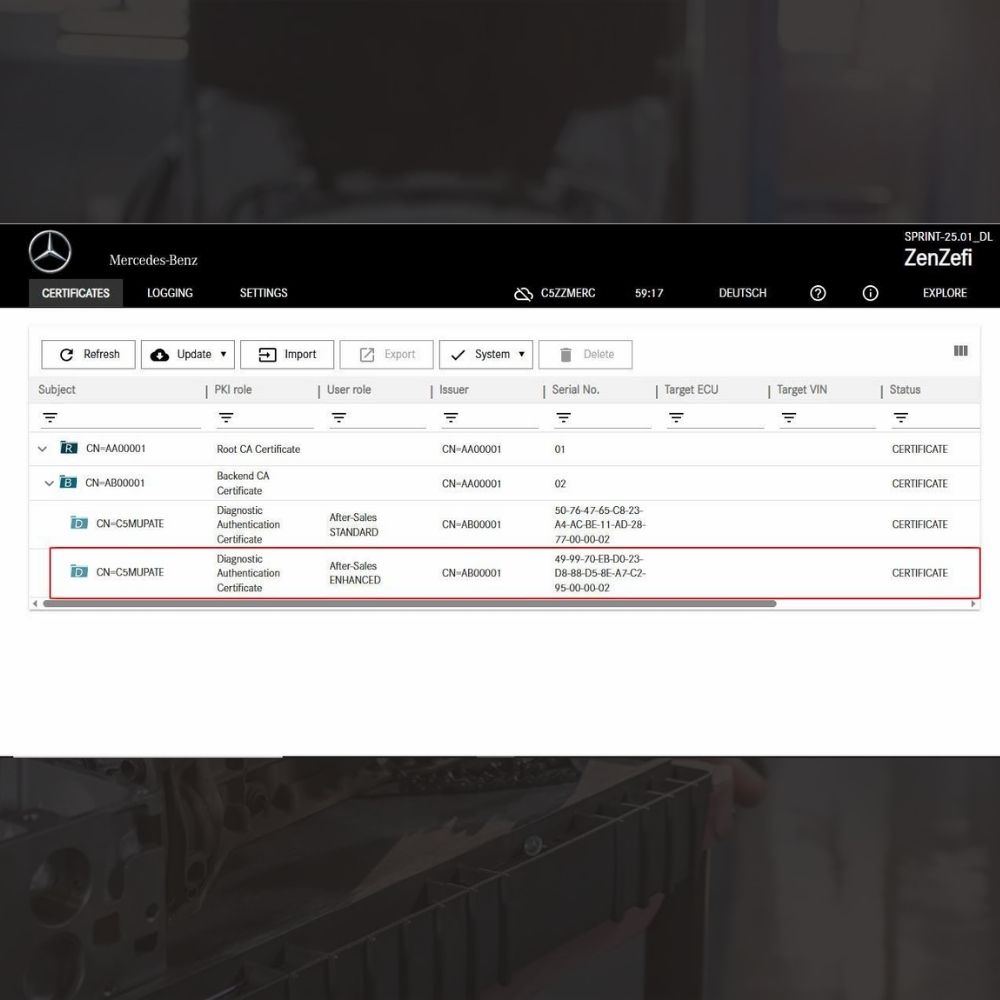
New Mercedes Car Coding Solution with ZenZefi certificate for DTS Monaco 9.02
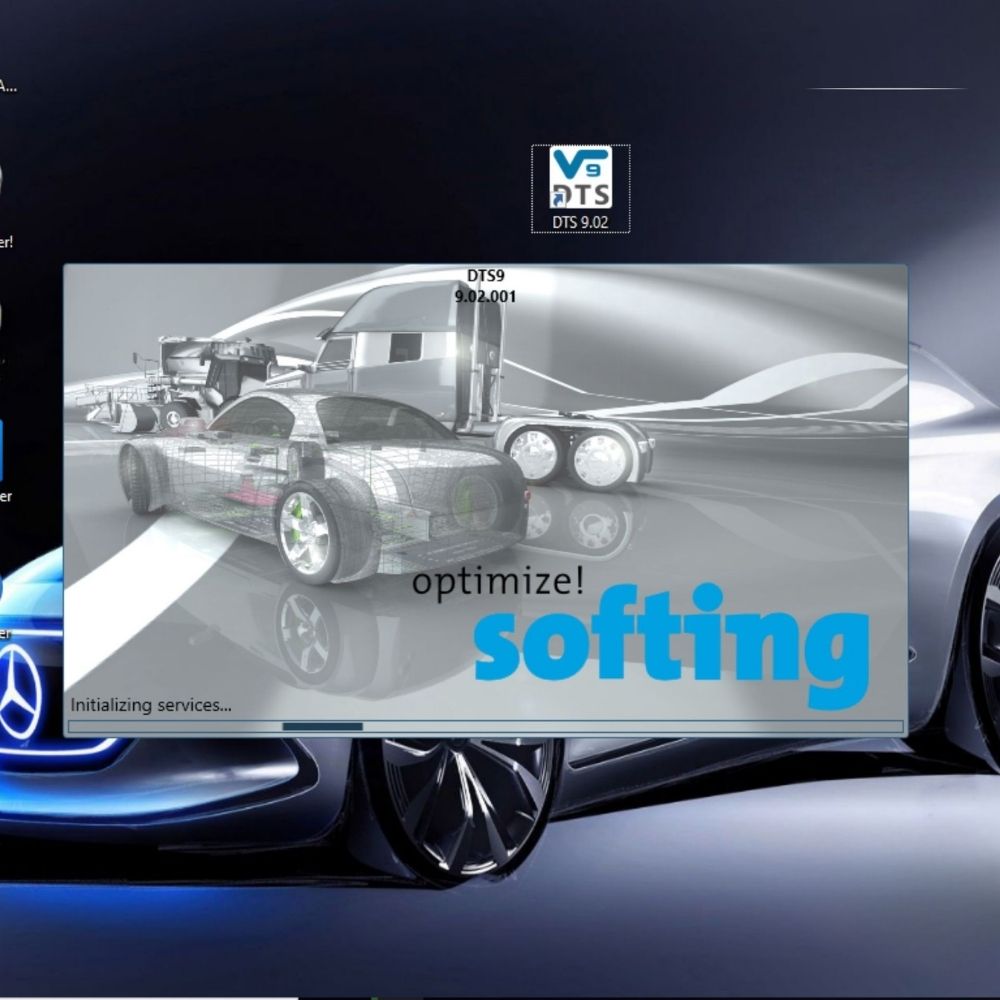
What is DTS Monaco? Key Functions of DTS Monaco Software






